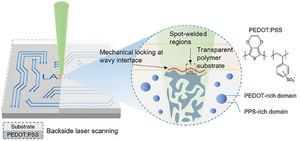Nano-Micro Letters ( IF 31.6 ) Pub Date : 2024-11-05 , DOI: 10.1007/s40820-024-01519-w Yibo Li, Hao Zhou, Huayong Yang, Kaichen Xu

|
Abstract
Despite the promising progress in conductive hydrogels made with pure conducting polymer, great challenges remain in the interface adhesion and robustness in long-term monitoring. To address these challenges, Prof. Seung Hwan Ko and Taek-Soo Kim’s team introduced a laser-induced phase separation and adhesion method for fabricating conductive hydrogels consisting of pure poly(3,4-ethylenedioxythiophene):polystyrene sulfonate on polymer substrates. The laser-induced phase separation and adhesion treated conducting polymers can be selectively transformed into conductive hydrogels that exhibit wet conductivities of 101.4 S cm−1 with a spatial resolution down to 5 μm. Moreover, they maintain impedance and charge-storage capacity even after 1 h of sonication. The micropatterned electrode arrays demonstrate their potential in long-term in vivo signal recordings, highlighting their promising role in the field of bioelectronics.
Graphical Abstract
中文翻译:

用于稳健生物电子学的激光诱导高度稳定的导电水凝胶
抽象
尽管用纯导电聚合物制成的导电水凝胶取得了可喜的进展,但在长期监测中的界面粘附和稳健性仍然存在巨大挑战。为了应对这些挑战,Seung Hwan Ko 教授和 Taek-Soo Kim 的团队引入了一种激光诱导相分离和粘附方法,用于在聚合物基材上制造由纯聚(3,4-乙烯二氧噻吩):p邻苯乙烯磺酸盐组成的导电水凝胶。激光诱导的相分离和粘附处理的导电聚合物可以选择性地转化为导电水凝胶,其湿电导率为 101.4 S cm-1,空间分辨率低至 5 μm。此外,即使在超声处理 1 小时后,它们也能保持阻抗和电荷存储容量。微图案化电极阵列展示了它们在长期体内信号记录中的潜力,突出了它们在生物电子学领域的前景。






























 京公网安备 11010802027423号
京公网安备 11010802027423号